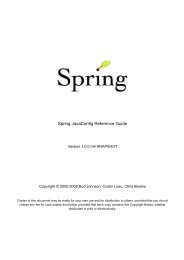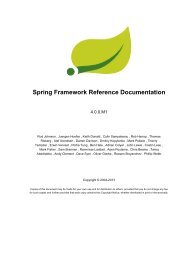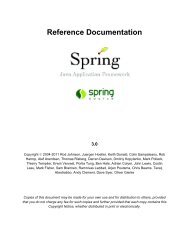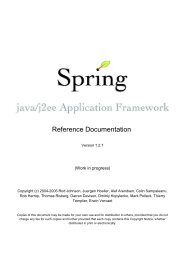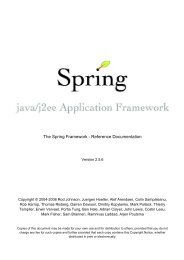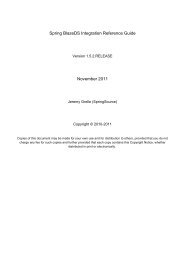Spring Data MongoDB - Spring Web Services - Parent - SpringSource
Spring Data MongoDB - Spring Web Services - Parent - SpringSource
Spring Data MongoDB - Spring Web Services - Parent - SpringSource
You also want an ePaper? Increase the reach of your titles
YUMPU automatically turns print PDFs into web optimized ePapers that Google loves.
please define productname in your docbook file!Assume we have 30 Person instances in the database. You can now trigger a request GET http://localhost:8080/persons and you'll see something similar to this:{ "links" : [ { "rel" : "next","href" : "http://localhost:8080/persons?page=1&size=20 }],"content" : [… // 20 Person instances rendered here],"pageMetadata" : {"size" : 20,"totalElements" : 30,"totalPages" : 2,"number" : 0}}You see that the assembler produced the correct URI and also picks up the default configurationpresent to resolve the parameters into a Pageable for an upcoming request. This means, ifyou change that configuration, the links will automatically adhere to the change. By default theassembler points to the controller method it was invoked in but that can be customized byhanding in a custom Link to be used as base to build the pagination links to overloads of thePagedResourcesAssembler.toResource(…) method.Repository populatorsIf you work with the <strong>Spring</strong> JDBC module, you probably are familiar with the support to populate a<strong>Data</strong>Source using SQL scripts. A similar abstraction is available on the repositories level, althoughit does not use SQL as the data definition language because it must be store-independent. Thus thepopulators support XML (through <strong>Spring</strong>'s OXM abstraction) and JSON (through Jackson) to define datawith which to populate the repositories.Assume you have a file data.json with the following content:[ { "_class" : "com.acme.Person","firstname" : "Dave","lastname" : "Matthews" },{ "_class" : "com.acme.Person","firstname" : "Carter","lastname" : "Beauford" } ]Example 4.23 <strong>Data</strong> defined in JSONYou can easily populate your repositories by using the populator elements of the repository namespaceprovided in <strong>Spring</strong> <strong>Data</strong> Commons. To populate the preceding data to your PersonRepository , dothe following:1.4.0.BUILD-SNAPSHOT<strong>Spring</strong> <strong>Data</strong> <strong>MongoDB</strong> -Reference Documentation 18




